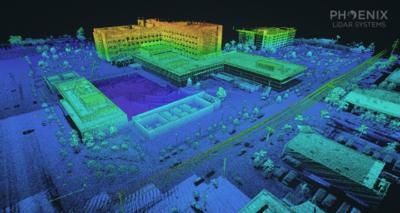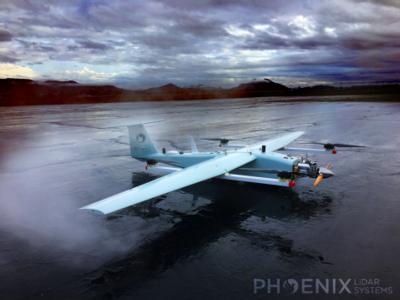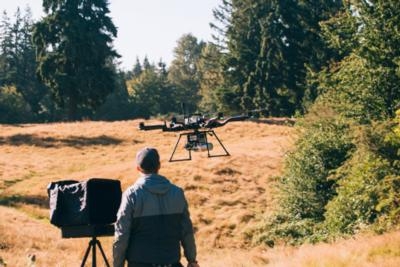In 2012, Phoenix LiDAR CEO Grayson Omans Had The Idea To Mount A Velodyne Lidar Sensor On A UAV—And Transformed The Aerial Mapping Industry In The Process
The aerial mapping industry has seen some significant changes with the rise of drone technology, among them the use of LiDAR to conduct detailed mapping of large areas in a short amount of time. According to Grayson Omans, CEO and co-founder of Phoenix LiDAR, he was first approached about marrying the two technologies for the first time back in 2012.

“Back then, these LiDAR sensors were pretty expensive, so it was a novel idea. I had high hopes for the result, but I never imagined that we’d both end up disrupting the aerial mapping industry,” Omans recalls.
The partnership between Velodyne and Phoenix took to the skies only six years ago, but already it has led to some remarkable innovations. Together, the two companies launched the industry's first commercial UAV LiDAR system, establishing today’s broad use of LiDAR-enabled Unmanned Aerial Vehicles (UAVs).
Phoenix, which builds custom LiDAR systems by integrating various sensors, GNSS relative position receivers, Unmanned Aerial Vehicles (UAVs) and more, went on to launch the industry’s first vertical take-off and landing (VTOL) fixed-wing UAV LiDAR system, the TerraHawk CW-20. For this innovation, Phoenix again chose a Velodyne LiDAR sensor. The TerraHawk allows surveyors to take advantage of the speed and stability of a fixed-wing UAV, while using VTOL to protect equipment in remote environments with no runway access.
“Our goal at Phoenix is to make drone LiDAR mapping easier and more affordable to any organization,” Omans adds. “We do a lot of research before we integrate a component into our LiDAR systems, and Velodyne has consistently offered a great balance between high power and affordability.”
One cost-saving innovation includes Phoenix’s real-time 3D point cloud visualizer, which helps surveyors confirm data quality in real time to avoid errors, and to make flight adjustments while still in the field. Another “first” is their cloud LiDAR post-processing platform, LiDARMill, which significantly reduces the complexity and expense of post-processing by allowing users to upload raw mapping data and to download processed data files in the industry-standard LAS format.
These accomplishments have established UAV LiDAR as a key resource for the aerial mapping and surveying industry, with Phoenix and Velodyne delivering a host of industry firsts. Customers the world over are able to leverage Phoenix’s systems to easily and inexpensively collect detailed 3D topographic information for a wide range of commercial and research applications, like mapping power line corridors, monitoring infrastructure, conducting ground surveys beneath dense vegetation, and more.
Phoenix technology helps organizations like the Colorado DOT to inspect transportation infrastructure, and companies like CSX to detect shifts in rail systems. UAV service companies, like North Dakota-based SkySkopes, perform a variety of industrial drone inspections, adding LiDAR to their offerings last year.

“Phoenix enables professional drone service providers like SkySkopes to expand our offerings,” says Matt Dunlevy, CEO of SkySkopes. “Our clients have a lot of unique needs, and we can now combine our tools with our Phoenix system to increase the range and quality of our data products.”
Meanwhile, Velodyne LiDAR is matching the furious pace of innovation, introducing products designed for the UAV industry that are smaller, lighter, and more powerful. These include the VLP-16 Puck, which delivers 16 laser channels and 100 meters of range in a small form factor, as well as the VLP-16 Puck LITE, which further reduces payload by weighing in at under 600 grams. Furthermore, Velodyne recently announced a 50 percent cost reduction for its VLP-16 Puck that will make the company’s most popular LiDAR sensor even more accessible.
“Phoenix LiDAR’s innovative spirit was instrumental to Velodyne’s entry into the UAV LiDAR market,” says Mike Jellen, President of Velodyne LiDAR. “We have since gone on to produce products specific to this space to ensure our continued leadership. Our close relationship with Phoenix LiDAR is a point of pride here at Velodyne. Together, we look forward to future innovation, as our two companies continue to transform the aerial mapping industry.”
Next week, Phoenix LiDAR will meet with industry leaders and members of the LiDAR community at the International LiDAR Mapping Forum (ILMF) in Denver, Colorado. The company will present Phoenix hardware systems and 3D data sets, and also the Phoenix Software Suite, which automates the more complex aspects of LiDAR mapping, from flight plan to acquisition to post-processing, enabling companies to streamline their LiDAR workflows and to expand their endeavors.

Fueled by applications across verticals, the development of drone and laser technologies will continue at a rapid pace. To capitalize on this forward progress, industry leaders increasingly rely on their own experience and vision along with mutually beneficial partnerships. If the history of collaboration between Phoenix and Velodyne is any indication, both teams look forward to maintaining their lead in developing their respective technologies.
(Source: Joint Velodyne/Phoenix LiDAR news release. Images provided)
 ANN's Daily Aero-Term (04.24.24): Runway Lead-in Light System
ANN's Daily Aero-Term (04.24.24): Runway Lead-in Light System ANN's Daily Aero-Linx (04.24.24)
ANN's Daily Aero-Linx (04.24.24) Aero-FAQ: Dave Juwel's Aviation Marketing Stories -- ITBOA BNITBOB
Aero-FAQ: Dave Juwel's Aviation Marketing Stories -- ITBOA BNITBOB Classic Aero-TV: Best Seat in The House -- 'Inside' The AeroShell Aerobatic Team
Classic Aero-TV: Best Seat in The House -- 'Inside' The AeroShell Aerobatic Team Airborne Affordable Flyers 04.18.24: CarbonCub UL, Fisher, Affordable Flyer Expo
Airborne Affordable Flyers 04.18.24: CarbonCub UL, Fisher, Affordable Flyer Expo





